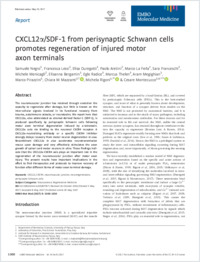CXCL12α/SDF‐1 from perisynaptic Schwann cells promotes regeneration of injured motor axon terminals
- Negro, Samuele Department of Biomedical Sciences, University of Padua, Padua, Italy
- Lessi, Francesca Laboratory of Genomics, Pisa Science Foundation, Pisa, Italy
- Duregotti, Elisa Department of Biomedical Sciences, University of Padua, Padua, Italy
- Aretini, Paolo Laboratory of Genomics, Pisa Science Foundation, Pisa, Italy
- La Ferla, Marco Laboratory of Genomics, Pisa Science Foundation, Pisa, Italy
- Franceschi, Sara Laboratory of Genomics, Pisa Science Foundation, Pisa, Italy
- Menicagli, Marco Laboratory of Genomics, Pisa Science Foundation, Pisa, Italy
- Bergamin, Elisanna Department of Biomedical Sciences, University of Padua, Padua, Italy
- Egle, Radice Institute for Research in Biomedicine (IRB), Faculty of Biomedical Sciences, Università della Svizzera italiana, Switzerland
- Megighian, Aram Department of Biomedical Sciences, University of Padua, Padua, Italy
- Pirazzini, Marco Department of Biomedical Sciences, University of Padua, Padua, Italy
- Mazzanti, Chiara M. Laboratory of Genomics, Pisa Science Foundation, Pisa, Italy
- Rigoni, Michela Department of Biomedical Sciences, University of Padua, Padua, Italy
- Montecucco, Cesare Department of Biomedical Sciences, University of Padua, Padua, Italy - CNR Institute of Neuroscience, Padua, Italy
-
30.05.2017
Published in:
- EMBO molecular medicine. - 2017, vol. 9, no. 8, p. 1000–1010
English
The neuromuscular junction has retained through evolution the capacity to regenerate after damage, but little is known on the inter‐cellular signals involved in its functional recovery from trauma, autoimmune attacks, or neurotoxins. We report here that CXCL12α, also abbreviated as stromal‐derived factor‐1 (SDF‐1), is produced specifically by perisynaptic Schwann cells following motor axon terminal degeneration induced by α‐latrotoxin. CXCL12α acts via binding to the neuronal CXCR4 receptor. A CXCL12α‐neutralizing antibody or a specific CXCR4 inhibitor strongly delays recovery from motor neuron degeneration in vivo. Recombinant CXCL12α in vivo accelerates neurotransmission rescue upon damage and very effectively stimulates the axon growth of spinal cord motor neurons in vitro. These findings indicate that the CXCL12α‐CXCR4 axis plays an important role in the regeneration of the neuromuscular junction after motor axon injury. The present results have important implications in the effort to find therapeutics and protocols to improve recovery of function after different forms of motor axon terminal damage.
- Language
-
- English
- Classification
- Medicine
- License
- Open access status
- gold
- Identifiers
-
- RERO DOC 327034
- DOI 10.15252/emmm.201607257
- ARK ark:/12658/srd1318989
- Persistent URL
- https://n2t.net/ark:/12658/srd1318989
Statistics
Document views: 161
File downloads:
- Texte intégral: 225
